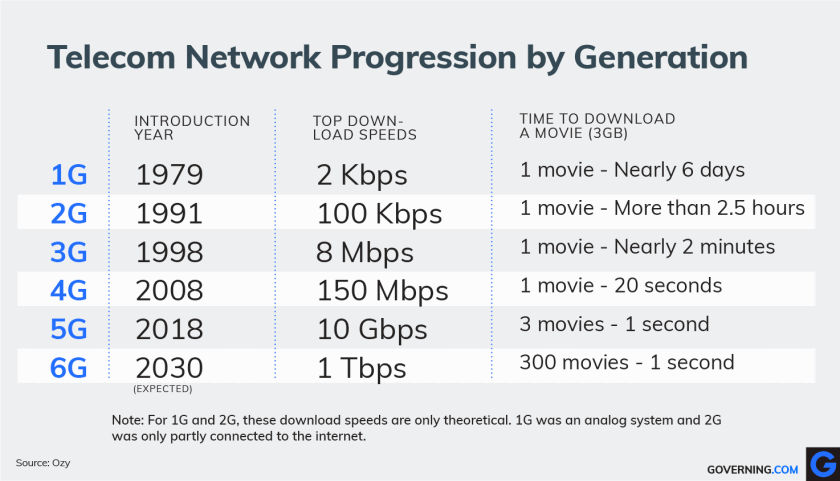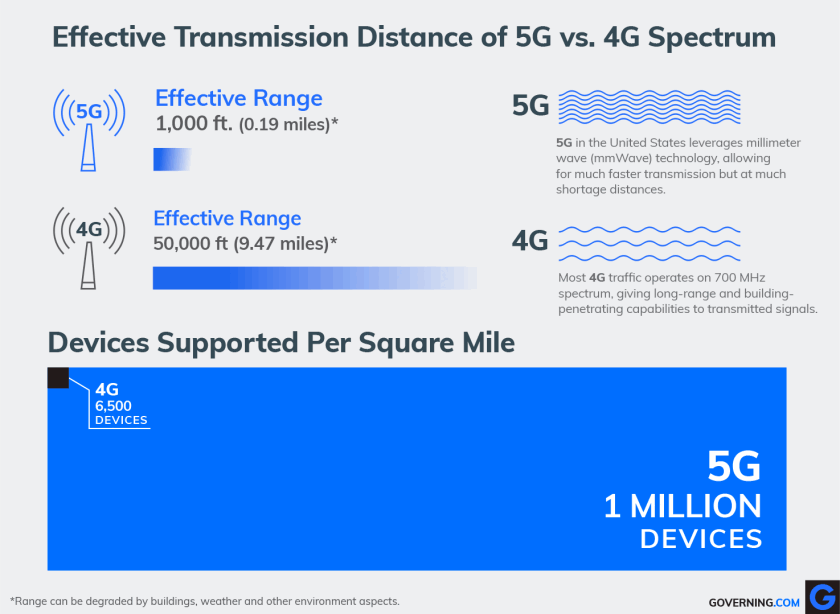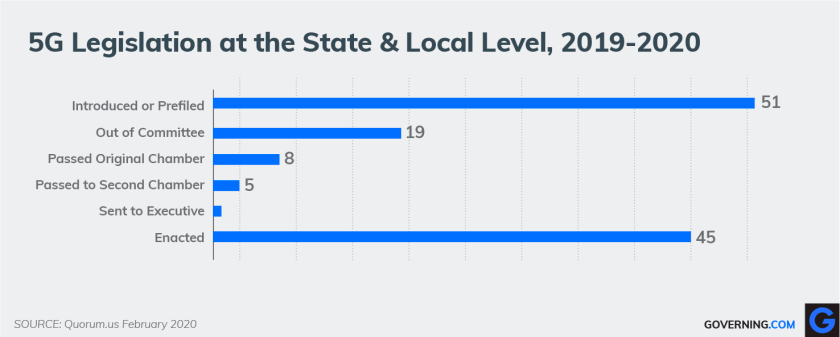What Is 5G?
5G is the fifth generation of wireless networking technology used in cellular networks. The first commercial rollout of 5G occurred in 2019. Deployment is expected to begin in earnest in 2020, increasing the need for governments to anticipate what lies ahead.The first generation of mobile networks, introduced in 1979, used analog radio technology and only allowed voice calls. Starting with the second generation, a switch to digital radio made it possible to send text messages and emails. Each successive generation brought greater transmission speed, opening the door to Internet browsing, video calls, streaming video and more.
5G will bring the biggest generational advance to date in network speed, but will require new phones and devices with new chips.

5G represents one of the biggest boosts in speed since the introduction of wireless networking in 1979. (ozy.com)
How Is 5G Different?
More and more devices, consuming more and more data, can strain bandwidth, slow services and drop connections. In the U.S., 5G will use a band of the radio spectrum that has never before been used for cellular data networks: high-frequency radio waves the length of millimeters rather than centimeters. This wide open “road” will accommodate more data and reduce delays in data transfer (latency) even in peak use hours. 4G towers were designed to support approximately 6,500 devices per square mile, whereas 5G can support upwards of 1 million devices in the same area.
5G transmits more data over shorter distances, reducing delays in transmissions while significantly boosting the number of devices supported per square mile, an important factor in edge and Internet of Things (IoT) computing.
How Can 5G Benefit States and Localities?
The potential upside to greater capacity and network speed is huge. Surges in cellular network use during emergency events are less likely to slow or prevent vital communications between citizens and first responders. 5G will be the underlying infrastructure to help usher in fully autonomous vehicles, intelligent public safety cameras and connected Internet of Things (IoT) devices used throughout city infrastructure. Jurisdictions with 5G networks are likely to attract tech-savvy residents and businesses that leverage those connections for new digital business models and reach new customers.5G Complications and Controversies
Tapping 5G’s potential does not come without complications. There are a number of reasons why both governments and citizens might be reluctant to embrace it.More Towers — The range of 5G towers is about 1,000 feet, less than 2 percent of the range of 4G network towers. This means that hundreds of thousands, and possibly millions, of new towers will be needed. The “towers,” which are small boxes with wireless antennas, will be densely deployed throughout cities. Many will be placed on public infrastructure such as streetlamps, traffic lights and utility poles and even under manhole covers. This will create permitting challenges.
Local Control Over 5G Deployment — Cities have sued both the FCC and state government agencies to retain their ability to control and regulate 5G towers. Dozens of cities are engaged in a legal battle with the FCC to retain control over what they charge telecommunication providers for access to city-owned infrastructure. Aesthetic objections from residents can also be expected.
Network Access — Not every device can access 5G. As of February 2020, there are only six phones available in the U.S. that can leverage the new 5G spectrum.
Health Concerns — This is a topic with potential for controversy. The World Health Organization notes that there are more studies regarding electromagnetic field (EMF) exposure than for most chemicals, and says that current evidence does not confirm the existence of health risks from low-level EMF exposure. Even so, as cellular networks continue to grow in number, scientists have called for more research. There are good reasons to acknowledge that there are things that remain to be learned. Discussions regarding earlier cellular networks have revolved around the low frequency waves they employ. 5G networks use high frequency waves, and scientists have indicated that they are less hazardous because they cannot penetrate the skin.
Digital Equity — Devices that can use 5G will be more expensive, adding to problems that already exist regarding digital equity.
Security — The Chinese firm Huawei Technologies is presently the world leader in 5G technology. This has prompted fears that 5G would be an open door for China to collect sensitive data. The federal administration is pushing companies such as Microsoft, Dell, and AT&T to develop 5G solutions. It also has proposed three different approaches to 5G to try to stop American telecommunication providers from using equipment manufactured by Huawei in China. The most recent proposal is centered around leveraging U.S.-based companies to create open and virtualized (or software-based) 5G infrastructure; however, the lack of consensus on the right development strategy is creating delays for future 5G rollouts.
Limits for Rural Broadband — The limited range of 5G small cell antennas means that deployment only makes sense in densely populated areas with many users. 5G will not open the door to improved connectivity for rural areas.
TV Concerns — The FCC auctioned off large chunks of the airwaves used by some broadcast TV stations to free up spectrum for 5G providers, forcing almost 1,000 to change their broadcast address. For now, the fix can be as simple as rescanning channels on television sets. Longer term, 5G networks are expected to support linear broadcast TV services over IP-based video in coordination with mobile operators. Both sets of changes will be of interest to local government constituents.
What Are 5G's Policy and Regulatory Issues?
Although 5G is not widespread in deployment, policymakers are already beginning to introduce legislation on its use. According to the legislative tracking service Quorum, 129 5G bills have been introduced in state legislatures since 2019 and 45 of those bills made it through the legislative process to become enacted.Much of the legislation to date has centered on explorative policies such as assembling working groups to analyze the design, security and future use cases of 5G. For example, on Jan. 14, 2020, New Jersey Assemblywoman Carol Murphy introduced Assembly Bill 1114 to create a 5G Network and Development Task Force for the state of New Jersey to “study and develop recommendations on how to harmonize the approaching rollout of ‘5th Generation’ (5G) wireless networks and future development within the State.”

Future regulatory issues will be centered on the deployment of 5G equipment and the increased density requirements for placing small cell towers. Many cities in New York have challenged Governor Cuomo’s proposal to create a statewide standard for approving and charging for the use of public infrastructure for 5G towers. (quorum.us)
states-most-active-in-5g.gif
A handful of states, led by Illinois, Massachusetts and Wisconsin, have been active in adopting 5G regulations.How Are Cities and States Approaching 5G Deployment?
5G has already been deployed to some extent in more than 30 major cities across the country. These efforts have primarily been led by private telecommunications companies that have partnered with cities to gain access to light poles and other public infrastructure to mount 5G antennas.For the foreseeable future, 5G will remain a wireless technology deployed in dense population centers that can justify the cost of deploying thousands of small cell antennas. There are other approaches that may eventually open up more reliable high-speed Internet access for rural communities such as the low-band approach T-Mobile/Sprint are taking to 5G or Internet from low-earth-orbit satellites such as Starlink from SpaceX.
5G on Governing.com
- 5G Doesn’t Resolve the Digital Divide, Could Make It Worse
- City Council Responds to Community, Adjusts 5G Regulations
- Ohio Residents Upset by Surprise 5G Tower Eyesores
- Phone Companies Race to Establish National 5G Networks










